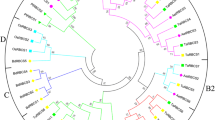Abstract.
The mitochondrial elongation factor EF-Tu (tufM) in rice (Oryza sativa L.) was isolated and characterized. The rice tufM cDNA clone contained 1,726 nucleotides and coded for a 453 amino acid protein including a putative mitochondrial transit peptide of 64 amino acid residues. This coding region was composed of 12 exons and 11 introns. The deduced amino acid sequence showed 62% and 88% identities with rice chloroplast EF-Tu (tufA) and Arabidopsis mitochondrial EF-Tu, respectively. As previously observed for the rice tufA gene, the tufM gene is likely present as one copy in rice. The mitochondrial EF-Tu gene was differentially expressed during flower development, and the other translational EF-Tu genes (chloroplast EF-Tu and cytosolic EF-1 alpha) were also distinctly expressed in a temporal manner. Phylogenetic analysis of the rice tufM gene showed that the mitochondrial tufA homologue of Reclinomonas was more closely related to the mitochondrial tufM genes of flowering plants than fungal and other mitochondrial tuf genes. In addition, the tufM encoded an N-terminal extension showing significant similarity to that of rps14 (or sdhB), which is also a nuclear-encoded rice mitochondrial gene.
Similar content being viewed by others
Author information
Authors and Affiliations
Additional information
Electronic Publication
Rights and permissions
About this article
Cite this article
Lee, .JH., Yoon, .HS., Yun, .CH. et al. Molecular characterization of the mitochondrial elongation factor EF-Tu gene in rice (Oryza sativa L.). Plant Cell Rep 21, 157–165 (2002). https://doi.org/10.1007/s00299-002-0469-5
Received:
Revised:
Accepted:
Issue Date:
DOI: https://doi.org/10.1007/s00299-002-0469-5




